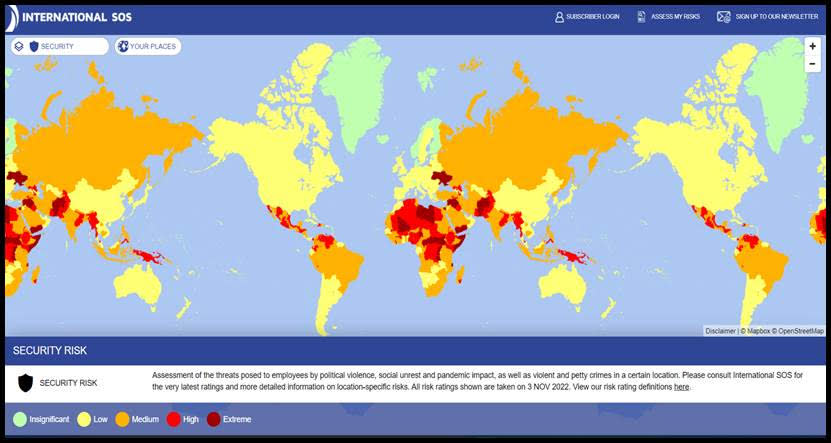These Are The Most Dangerous Countries To Visit In 2023, According To This Year's Travel Risk Map

Safety is an important factor when traveling. With recent incidents abroad, travelers are taking extra precautions when planning trips. Countries like Afghanistan, Iraq, Mali, Syria, and Ukraine all rank as some of the most dangerous destinations for business and pleasure travel in the world, according to the recent Travel Risk Map.
The index is put together by risk assessment firm International SOS’s global security and medical specialists. The map was created in 2015. This year is the first time the index counted mental health disorders such as anxiety, eating disorders, depression, and schizophrenia.

Related: Tourist Murdered While Wife Hid In Hotel Bathroom
How is the list compiled?
Countries’ security levels are determined by the threat to employees by political violence, including politically motivated unrest, terrorism, social unrest as well as petty crime, and other factors.
The countries at “extreme risk” for 2023 because of security include Afghanistan, Iraq, Mali, Somalia, Syria, and Ukraine. These countries experienced a “serious threat of violent attacks by armed groups targeting travelers and international assignees,” according to the site.
Ukraine was ranked “medium risk” but is now at the extreme level after its February invasion by Russia.
What are the “low-risk” countries?
The countries that rank “low risk” are the U.S., Canada, Australia, and most European countries. In the medical category, which ranks countries’ COVID-19 health care, infectious disease standards, and the quality of pharmaceutical supplies, the “low-risk” countries are the U.S., Canada, Australia, New Zealand, and most of Western Europe.
The “very high-risk” countries in the medical category include Afghanistan, Haiti, Mali, Niger, Libya, North Korea, Somalia, and Syria.
Countries that received high scores in medical safety and security ranked low in the mental health category and vice versa. The index shows that between 15% and 17.5% of people experienced mental health problems in Western Europe and most of Scandinavia. On the other hand, 17.5% to 20% experience mental health issues in Australia, Greenland, Spain, and New Zealand.
According to the World Health Organization, one in seven people in the world deal with at least one mental or substance abuse disorder. WHO reveals that anxiety and depression rates increased by 25% during the first year of the COVID-19 pandemic.
Dr. Irene Lai, medical director at International SOS said in a statement, “With travel and health risks on the rise in many regions, it is important for organizations to also focus on mitigating the ongoing impact of mental health issues.”
Lai continues, “Although other acute medical issues which may have a significant impact regularly arise, mental health problems remain in the background and cannot be overlooked.”
Related: Seattle Is The Best City For Singles To Find Love, Study Says

